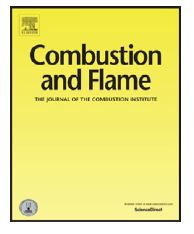Flame propagation in nano-aluminum–water (nAl–H2O) mixtures: The role of thermal interface resistance
Abstract

A detailed numerical analysis of flame propagation in nano-aluminum–water (nAl–H2O) mixture is performed. Emphasis is placed on investigating the role of particle thermal conductivity in the prediction of the burning properties of the mixture. Flame structure and burning characteristics are obtained by solving the energy equation using finite difference discretization and the Gauss–Seidel iteration method. Particle thermal conductivity is modeled using the temperature-dependent thermal conductivities of the aluminum core and oxide layer, as well as their interface resistance. The effective thermal conductivity of the mixture is modeled as a function of temperature, spatial coordinate, and local mixture composition, by means of the unified Maxwell–Eucken–Bruggeman model, accounting for random particle distribution and inter-particle interaction. Results indicate that the combined thermal resistance offered by the oxide layer and the interface constitute 95% of the total resistance of the particle. The calculated particle-size dependent linear burning rates show good agreement with experimental data, with only 5% error. Error in burning rate prediction increases, however, to 20% when interface resistance is excluded from the particle thermal conductivity model. It was also observed that burning rate varies as the inverse of particle size. Finally, an analysis of the sensitivity of burning rate to the individual components of the particle thermal conductivity model is also performed. Results suggest a 30% decrease in burning rate for two orders of magnitude reduction in both interface conductance and oxide thermal conductivity. The burning rate drops by only 15%, however, for a similar reduction in aluminum thermal conductivity. A heat conduction perspective on flame propagation in nanocomposites is presented, identifying the highest and the lowest conductive pathways for energy transport.
